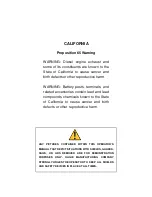
9
5.
Do not use your hand to check for leaks. Use a piece of cardboard or paper to search for leaks.
6.
Stop the engine and relieve pressure before connecting or disconnecting hydraulic or fuel lines.
7.
Tighten all connections before starting the engine or pressurizing lines.
8.
If fluid is injected into the skin, obtain medical attention immediately.
9.
The cooling system is operated under pressure which is controlled by the radiator cap. It is dangerous to
remove the cap while the system is hot. Allow the engine to cool, then turn the cap slowly to the first stop
and allow the pressure to escape before removing the cap entirely.
10. Continuous long term contact with used engine oil may cause skin cancer. Avoid prolonged contact with
used engine oil. Wash skin promptly with soap and water.
11. Do not run the tractor engine in a closed building without adequate ventilation as exhaust fumes may
suffocate you.
12. Do not modify, or alter, or permit anyone else to modify, or alter the tractor, or any of its components, or
any tractor function without first consulting your Authorized Dealer.
13. Tractor wheels are heavy. Handle them with care and ensure that, when stored, they cannot topple and
cause injury.
14. Discard the used lubricating oils and filter canisters in accordance with local regulations.
1.3. Fire precautions.
1. Under no circumstances should gasoline, alcohol or blended fuels be added to fuel oil. These combinations
can create an increased fire or explosive hazard. In a closed container, such as a fuel tank, these bends
are more explosive than pure gasoline.
Do not use these blends.
2. Never remove the fuel cap or refuel with the engine running or hot.
3. Do not smoke or allow an open flame near the fuel tank or while re-fuelling the tractor. Wait for the engine
to cool before re-fuelling.
4. Maintain control on the fuel filler pipe nozzle when filling the tank.
5. Do not fill the fuel tank to its capacity. Allow room for expansion.
6. Wipe up spilled fuel immediately.
7. Always tighten the fuel tank cap securely.
8. If the original fuel tank cap is lost, replace it with an approved cap. A non-approved cap may not be safe.
9. Keep equipment clean and properly maintained.
10. Do not drive equipment near open fires.
11. Should the fuel catch fire, extinguish fire covering it tightly with asbestos blanket, canvas sheet or rags, or
else by pouring sand or soil over the fire. Never use water to extinguish burning fuel or lubricants as this
makes the fire to spread even faster. A fire extinguisher should be carried with the tractor.
12. Use fuel oil with a minimum cetane rating of 40. At very low ambient temperatures and/or at high altitudes,
a fuel with a higher cetane rating is required.
13. Fuel oil with a sulphur content above 1.3 % is not recommended.
14. Precautions should be taken to ensure that stored fuel is kept free of dirt, water, etc.
15. Fuel should be stored in black iron tanks, not galvanized tanks, as the galvanized coating will react with the
fuel and form compounds that will contaminate the injection pump and injectors.
16. Bulk storage tanks should be installed away from direct sunlight and angled slightly so that the outlet pipe is
at the higher end. In this way sediment in the tank will settle away from the outlet pipe.
17. To facilitate moisture and sediment removal, a drain plug should be provided at the lowest point (at the
opposite end to the outlet pipe). If there is no filter on the outlet pipe, then a funnel with a fine mesh screen
should be used when filling the tractor fuel tank.
18. Fuel purchases should be arranged so that summer grade fuels are not held over and used in winter and
vice-versa.
WARNING:
!
The fuel oil in the injecting system is pressurized and can penetrate human
skin with fatal results. Adjustment of fuel injection equipment should not be
carried out by unqualified persons.
Safety frame or roll bar (where fitted)
Your tractor is equipped with a CAB/ROPS which must be maintained in a serviceable condition. Be
careful when driving through doorways or working in confined spaces with low headroom.

































